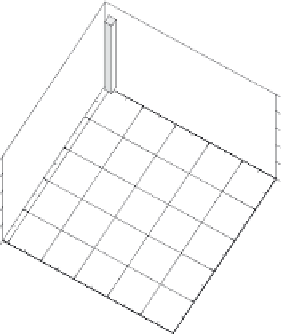Geoscience Reference
In-Depth Information
a
1000
800
b
600
σ
v
(kPa)
400
1000
200
2000
800
10
600
1500
400
8
σ
v
(kPa)
1000
200
2000
500
6
10
1500
10
X(m)
8
4
1000
6
8
4
500
2
Y(m)
2
6
10
0
0
X(m)
8
4
6
4
2
Y(m)
2
0
0
Fig. 10.11. (a)Pressuredistributionbeneath a vertically loaded rigidsquare shallow
foundation. (b) Withmoment superimposed on the vertical load
moment in this case is such that one edge of the foundation is at the point of generating
negativecontactpressure,thatistheedgeofthefoundationisabouttostartpullingonthe
soilbelow,clearlythisisnotpossible,andtheundersidewillstarttodetachfromthesoil.
Thus for both vertical and moment loading of rigid shallow square foundations on a
continuous elastic soil the reaction pressure distribution is far from constant, or linear,
and is concentrated towards the edges. It is the concentration of the reaction towards
the edge of the foundation that is the explanation for the rotational stiffness of the foun-
dation on the continuous elastic soil being so much larger than the rotational stiffness
of the same sized foundation on a bed of springs, the stiffness of which is adjusted so
that the vertical stiffness of the foundations is the same. The underlying reason is that
for the spring foundation there is no interaction between the springs so that what hap-
pens at one point has no communication with what happens at the other points. In the
FEMA 273 document an attempt is made to address this problem by recommending that
the springs at the edge of the foundation stiffer than those under the centre part of the
foundation.
If one is concerned only with elastic modelling this incompatibility between the two
modelscanberemediedbyaddinganadditionalrotationalspringbeneaththefooting,or
alternatively adding additional width to the footing and adjusting the spring stiffnesses
so that the vertical and rotational stiffnesses of the footing from the spring model are the
same as those for a continuous elastic medium. Both of these approaches were explored
by Wotherspoon et al. (2004) and Pender et al. (2006). However, one can ask why go to
allthistrouble?Surelythecorrectfoundationstiffnesscanbeobtainedbyusingseparate







































































































































































































































































































































































































































































































































































































































































































































































































